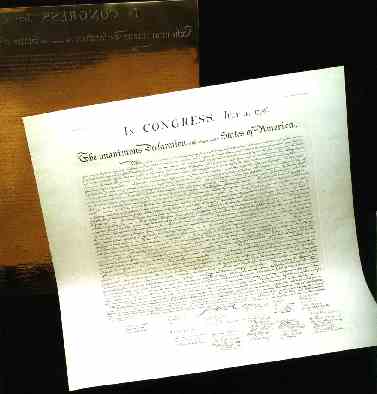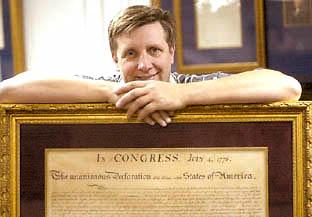Samuel Chase - Signer of the Declartion of Independence Biography by
Appleton's edited by Stanley L. Klos
Samuel Chase

Signer of the Declaration of Independence
SAMUEL CHASE was born
April 17, 1741 in Somerset County, Maryland. His father was an Episcopalian
clergyman of English birth, and a fine classical scholar who had charge of his
son's early education and sent him at the age of eighteen to study law at
Annapolis. Samuel was admitted to the bar in 1761 and began his practice.
He was soon a prominent lawyer and became a member
of the colonial legislature where he distinguished himself by his independent
bearing and by his opposition to the royal governor. He was an ardent patriot,
vehemently resisting the Stamp Act. He was prominent in the "Sons of Liberty", a
group of patriots in Annapolis that forcibly opened the public offices,
destroyed the stamps and burned the collector in effigy. The Maryland convention
sent him as one of five delegates to the first continental congress of 1774 and
he continued a member of successive congresses until the end of 1778.
Chase continuously debated aggressively for
independence, although his Maryland delegation had been restricted from voting
for independence from Britain. Mr. Chase could not stand the thought of being
obliged to withhold support from a measure he so enthusiastically favored,
gladly accepted from congress a mission to Canada in the company of Charles
Carroll and Benjamin Franklin. The object of the mission was to persuade Canada
to join the colonies, but the journey was fruitless. Chase was the most
aggressive anti-British leader in Maryland and upon his return from Canada he
and his colleague, Charles Carroll, took to the open road on horseback to make
impassioned speeches for independence at farms and towns throughout the
colony. Their campaign was successful and the Maryland delegation reversed its
position and urged an all out vote in favor of independence.
Chase returned to Philadelphia just in time to
join in adopting the decisive resolution. He was appointed on most of the
important committees where his industry was unwearied. He remained in Congress
several years, but became discredited in 1778 when charged in the newspapers
with taking advantage of inside information in order to deal in flour; he did
not regain political prominence for a decade. During the last two or three years
of the war he devoted himself to his private law practice and in 1783, he was
sent to England by the Maryland legislature to recover money that had been
invested in the Bank of England before the war. He remained there for nearly a
year and succeeded in recovering $650,000 and made the acquaintance of many
prominent lawyers.
Business enterprises into which he entered turned
out badly, and in 1789 he was insolvent. Meanwhile, he had assumed judicial
office in Baltimore and he afterward became chief judge of the general court of
Maryland. All his actions were accompanied by considerable turmoil and he was
criticized for holding so many offices.
In the 1790's, Chase became a pronounced
Federalist, and in 1796 President Washington appointed him as associate justice
of the Supreme Court. His colleagues did not view him very favorably at the
time, and his career on the bench turned out to be one of the stormiest on
record. He revealed his intellectual power in some of the most important
decisions, but his bullying tactics in the sedition trials, and his use of the
bench for partisan harangues against the Republicans, led to his impeachment
during the Presidency of Jefferson. He deserved rebuke for his highhanded
partisanship, but he had not been guilty of high crimes and misdemeanors within
the constitutional framework, and he was acquitted. Chase's judicial career was
relatively unimportant from that time on, partly because of his sufferings from
gout. He remained on the court until he died in Baltimore on June 19, 1811 at
the age of seventy.
Chase was twice married: to Ann Baldwin of
Annapolis, who bore him two sons and two daughters; and to Hannah Kilty Giles,
an Englishwoman by whom he had no children.


Source:
Centennial Book of Signers
Declaration of Independence
A Brief History and early record of
the printings
Click
Here

William Stone Copper Plate and 1976 Printing Photo
Courtesy of the National Archives
Click to Enlarge
Authenticate your Declaration of Independence -
Click Here
The 56 signatures on the Declaration appear in the positions indicated:

About Stanley L. Klos
Click Here to return to Rebels with of Vision



























































